Kathmandu, the capital city of Nepal, is surely one of the world’s most amazing cities, being endowed with a very large number of ancient monuments, historic temples and other interesting spiritual sights. Here, the presence of Buddhist and Hindu deities are found side by side, and devotees have a rare opportunity to view Vaisnavism in a predominantly Buddhist milieu.
Known for its namesake, the Kathmandu Valley, this place is believed by many to be the fabled and mysterious Shangri-La. Founded by King Gun Kamdev in 723 AD, the area of Kathmandu was previously a lake, but after a hill to the south was cut open by Manjushri, the Buddhist deity of wisdom, the water poured out and the region became habitable. The origin of the present name is unclear, but one of the more likely theories is that it was named after Kastha-Mandap (“temple of wood” in Sanskrit). This pagoda was carved from the single tree that was constructed on the orders of King Laxmi Narashingha Malla in 1596.
[wp_ad_camp_1]
Krishna Mandir
Krishna Mandir is one of the most central and famous temples in all of Kathmandu. Six and a half years in building, it was completed under Siddhi Narasimha Malla in 1637. The elegant shikhara-style temple ranks as one of the gems of Durbar Square. Encircled at ground floor level by an arcade, tier upon tier of small shrine-like pavilions culminate in a slender central tower. An inscription likens the temple with its 21 pinnacles to the sacred Mount Meru, abode of the god Shiva.
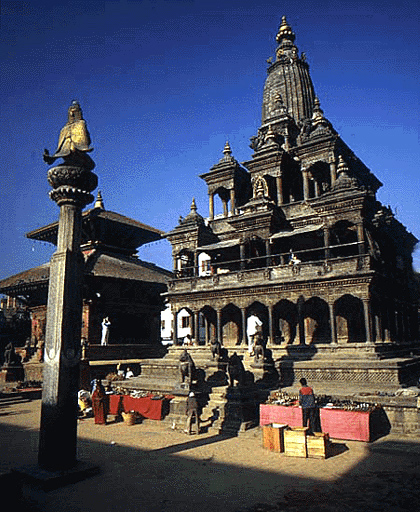
The temple is noteworthy not only for the excellence of its architecture but also for its detail, the reliefs being executed with a precision rarely found in wood let alone stone. This is especially true of the scenes from the Mahabharata and Ramayana epics which, complete with Newari commentary, embellish the ledges of the first and second floors. The unusual floral decoration of the arcade echoes the Islamic architecture of northern India, as indeed does the temple as a whole. It was thought to have been modeled on the Krishna Temple at Mathura. As we noted in a recent Sun article, much of the artistic stone work of the Kathmandu area was inspired by Mathura spiritual art.
Prior to consecration of the temple, Lord Krishna is said to have appeared to the King in a dream, instructing him to install an old religious symbol rather than a new one. But the only statue of Krsna the King could find was missing its left toe, a blemish which led him to commission a new image after all. Krishna then appeared a second time, telling the King that the missing toe was a real injury inflicted by a huntsman. So the damaged statue was duly installed. During the ceremony King Pratapa Malla and his guru arrived from Kathmandu disguised as snakes, intent on sabotaging the proceedings. They were recognized by King Siddhi Narasimha’s own guru, Vishvanatha Upadhyaya, who used his magic powers to trap the snakes under his seat until the ceremony was completed. The grateful King conferred on Vishvanatha Upadhyaya the hereditary office of priest at the Krishna Temple. A priest still lives there today, on the first floor.
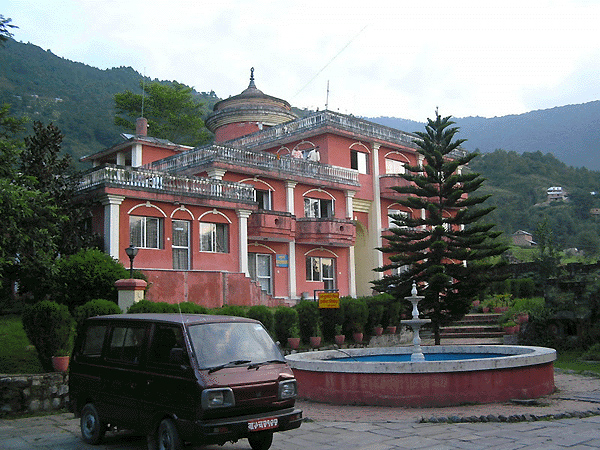
ISKCON Budhanilkantha Temple
A newer and super-excellent addition to this ancient community of temples is the ISKCON Krishna Mandir, a beautiful abode for Their Lordships.
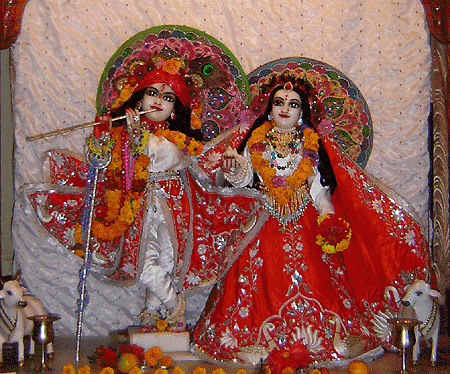
Hanuman Dhoka
The Hanuman Dhoka is an ancient palace and temple complex in the middle of the old city. Built during the Malla period, the area consists of a number of different monuments, the most outstanding of which are as follows:
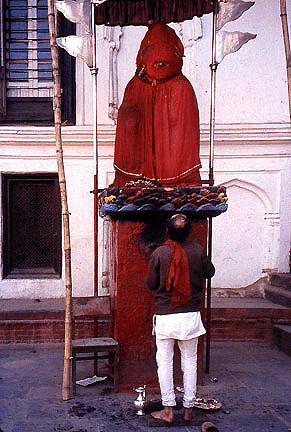
Standing to the left of the main entrance to the Hanuman Dhoka Palace is an image of Hanuman, the great devotee of the Lord. The Mallas placed this image of Hanuman at their palace gate both to protect the palace and to bring them victory in war. The image is made of stone, but each year is coated with a layer of red pigment made by mixing oil and vermillion powder. Over the years these repeated layers of pigment have distorted the face almost beyond recognition. The idol is always clothed in red, and is further honoured by the golden umbrella placed over its head. This particular murti, and also the smaller one just beyond it, were erected in 1672 by King Pratap Malla.
To the right of the image of Hanuman is the Golden Door, the main entrance of the Hanuman Dhoka Palace. It is guarded by a pair of stone lions. Shiva sits on the lion, to the right, while Shakti sits on the lionness to the left. These custodians undoubtedly date from Malla times; the golden door itself, however, is of a later period. The inscription above the door states clearly that it was erected in 181 0 during the reign of King Girbana Yuddha Bikram Shah. Hundreds of outdated copper plate inscriptions were gathered and sold, the profit from which bought the gold that was then pounded into sheets and moulded to the posts and panels of the door.
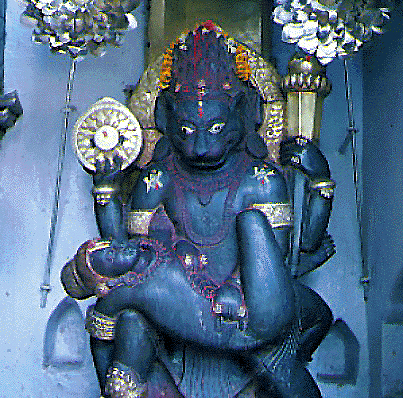
Above the golden door, in a niche formed by a large window opening, there are three interesting images. The central piece shows Krishna Bishwarupa, the multiple arms, the skulls and the terror image, are all indicative of a strong tantric influence. To the left is a group of three figures. The central figure is clearly of Krishna, and very likely the other two are meant to represent his two favourite consorts, Rukmini and Satya Bhama. The group on the right of the Bishwarupa is comprised of two seated figures. One of these figures, wearing royal robes and insignia, is playing an instrument. Seated near him in an attentive attitude is a woman, well dressed, heavily ornamented. The face of the king resembles very closely the features found on known images of King Pratap Malla; it can therefore be concluded that all the images date from Pratap Malla’s time (1641-74).
Nasal Chowk
Passing through the Golden Door one enters Nasal Chowk, the largest of ten courtyards found inside Hanuman Dhoka Palace. Nasal Chowk is frequently mentioned in the historical literature dealing with the Malla period as well as in the documents of different Shah kings. Many of the buildings that surround this courtyard date from the Shah period, but a fair proportion of them also date from an earlier period. Most of the art objects and images found in Nasal Chowk date from the Malla period. On the eastern side of Nasal Chowk there is a small shrine of Nasaleshwar, from which the courtyard gets its name.
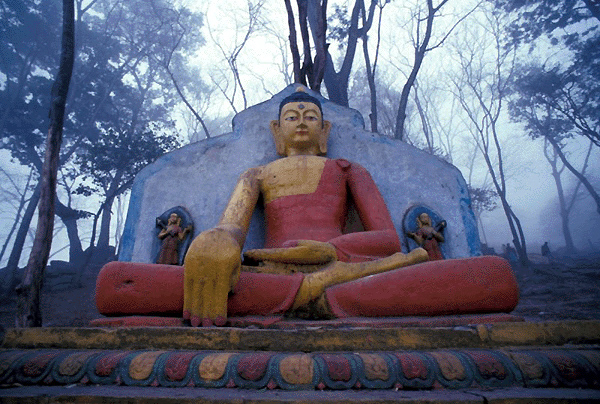
Mohan Chowk
To the north of Nasal Chowk lies Mohan Chowk, the residence of the Malla kings of Kathmandu. It was built in 1649 by King Pratap Malla (1641-74) and later repaired and ‘modernised’ during the reign of King Rajendra Bikrarn Shah in 1822.
One of the central features of Mohan Chowk is the Sundhara or golden water spout. Bringing water from Budhanilkantha, eight kilometres north of the city, to the Palace was a major project in the seventeenth century Nepal, but nevertheless was accomplished. Pratap Malla celebrated the event by erecting this fabulous setting for the new spout from which poured cool and clear water. The Sundhara is about 3.5 metres below ground level, so one has to descend to it. The spout itself is a sculptor’s dream of birds and beasts, while the wails around it are lined with thirty-six images of gods and goddesses, all of them beautiful works of art. In these magnificent surroundings, the king of Kathmandu performed his morning ritual bathing ceremonies and then ascended to the large stone throne above the Sundhara to complete his morning devotions.
On the northern wall of the quadrangle is a lengthy inscription of King Pratap Malla, setting out the arrangements made to finance the worship of his many deities. Above this inscription are two rows of images affixed to the wall. The images in the upper row show the ten incarnations of Vishnu and various scenes of Krishna at play, all perfectly in keeping with the religious tone of Mohan Chowk. There are also some images commemorating one of the earliest contacts between Kathmandu and the West.
Ganesh, Narasimha and Hanuman guard the entrance to Sundhara Chowk, the most southerly of the palace courts. Erected in 1627 as residence of the royal family, it too fell victim to the fire; it was rebuilt by Srinivasa Malla. Roughly translated Sundhara Chowk means “beautiful court”, an apt description of this delightful little quadrangle. The surrounding three-storied buildings are adorned with fine wood-carvings on the door and window frames.
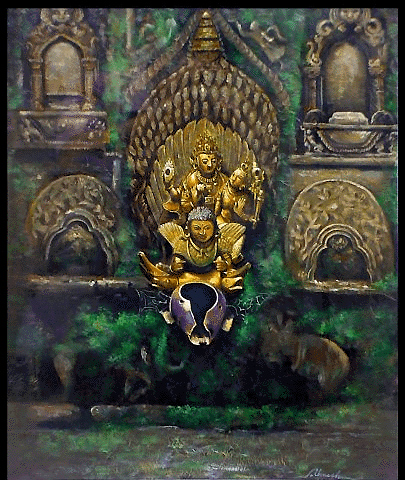
The show-piece of Sundhara Chowk is the Tusa Hiti, a sunken bath built for the Malla kings. Water flows from gilded makaras into the octagonal tank, so shaped in honor of the eight nagas, deities of fertility and rain. Immediately above the makaras, Vishnu and Lakshmi are borne aloft on Garuda’s back. A miniature version of the Krishna Mandir on Durbar Square graces the head of the pool.
The sunken bath is encircled by a double, sculpted frieze, intricately carved with spreading foliage. Filling the arbor-like recesses are figures of Tantric deities, including the Ashta Matrikas, the eight Bhairavas and the eight nagas. The pantheon extends onto the paving of the court. Two nagas, their heads raised towards bathers leaving the pool, form a nagh bandh – a garland of snakes warding off evil spirits – around the rim.
Basantapur Chowk
At the south-east corner of the Nasal Chowk is an exit through which one can pass into Basantpur Chowk. During the time of King Prithvi Narayan Shah, the Shah kings moved from the old quarters formerly occupied by the Malla kings into this section of the Palace. While the woodcarvings in the central courtyard are an especially outstanding feature, the whole building is of equal historic value to all Nepalese.
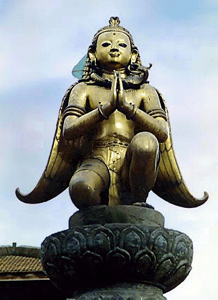
Tajeju Mandir
Built in 1564 by King Mahendra Malla, this is the most famous of the three Taleju temples built by the Malla kings. It is situated in Trishul Chowk, an appendage of Hanuman Dhoka Palace, but can also be approached by way of the Singha Dhoka or Lion Gate. The temple stands over 36.6 metres high, resting on a twelve stage plinth. Its three roofs soar above the rest of the Hanuman Dhoka complex, and until very recent times, it was considered very inauspicious to build a house higher than this temple. At the eighth stage of the plinth, the step broadens out into a spacious platform on which a wall is mounted, barring further progress.
On the platform just outside this wall there are twelve miniature temples, each with a double roof and all other appurtenances of a temple built in the Nepalese style. The same theme is repeated inside the wall, where there are four more such temples, each housing a deity, and each having a spire, one of the symbols of the attributes of Taleju goddess. On the south side, where the main door is found, there are large stone images of men and beasts, each one a powerful protecting force. At the top, on the final stage of the plinth, is a finely wrought bell on either side of the main door of the temple, one erected by Pratap Malla in 1654 and one by Bhaskar Malla in 1714. They are rung only when worship is offered to goddess Taleju.
Mul Chowk
Mul Chowk was the scene of almost all the truly important functions of the Malla period. Religious rites of all descriptions, royal weddings, the investiture of the crown prince as well as the coronation of the king himself, all took place here. According to the Bhasha Vamsavali, the Mul Chowk was built by Mahendra Malla in 1564 while he was building the great Taleju Temple; Bhaskar Malla then rebuilt it in 1709, giving it its present appearance.
Mul Chowk is shaped very much like a vihar or Buddhist monastery with a square courtyard surrounded by a two-storeyed quadrangle of buildings. The southern wing of the quadrangle is by far the most important, housing, as it does, a second and smaller, but nontheless beautiful temple of Taleju. On the ground floor of the three wings of the quadrangle there are large, open verandas. In the centre of the courtyard there is a low post set in the ground where animals are sacrificed at Dashain festival. At this time Taleju is worshipped within the small temple according to secret rites. The temple is on the south side of the Mul Chowk, facing north. To the right and left of its golden door, life-sized images of Ganga and Jamuna stand in poses of graceful service. Above the door, an impressive torana, carries in it central place of honour an image of goddess.
Apart from the above mentioned courtyard and temples of the Hanuman Dhoka complex, there are also a number of other interesting and historic temples in the vicinity. Some of the more important ones are described here.
Kastha Mandap
A three-storyed building, Kastha Mandap has an open ground floor, underlining its original purpose as a public building. The decorations and carvings added over the years have greatly enhanced the original design, bringing it closer to the appearance of a shrine. The central image in Kastha Mandap is of Gorakhnath. At each of the four corners is an image of Ganesh, the elephant-headed god.
Bhagavati Temple
This temple has perhaps the most interesting history of any temple in the Hanuman Dhoka area. It is at present dedicated to the goddess Bhagavati and consequently is also known as the Nuwakot Bhagavati temple. Its special importance stems from the fact that King Prithvi Narayan Shah had a great devotion to Nuwakot Bhagavati and is said to have brought her image with him when he unified Nepal under one flag. After taking the city, he set up the image in this temple, from which it is taken in April each year on a visit back to Nuwakot, some fifty-seven kilometres north of Kathmandu, and returned a few days later.
The temple itself was built long before he took over Kathmandu. Apparently King Jagajjaya Malla (1722-36) built it and named it Mahipatindreshwar in memory of his grandfather Mahipatindra Malla. The image of Mahipatindra Narayan was subsequently stolen (1766), and the shrine was empty when King Prithvi Narayan Shah entered the city in 1768. Since Prithvi Narayan had with him the image of Bhagavati, it was quite normal for him to place it in this empty sanctuary close to the Palace.
The Great Bell
Without the great bell erected by King Rana Bahadur Shah in 1787, the Palace area would have seem incomplete. The bells in the Patan Durbar Square and the Bhaktapur Durbar Square date from 1736. For some reason Kathmandu did not imitate this achievement immediately though it was in the same year that Jaya Prakash Malla came to power. Sixty years later, King Rana Bahadur Shah filled the deficiency by providing this bell to drive off the evil spirits. The bell is rung only when worship is being offered in Degutaleju.
The Great Drums
Located close to the great bell, two huge drums were made during the reign of Girbana Yuddha Bikram Shah (1799-1816) and are played only during the worship of Degutaleju. An inscription on copper plate, in the keeping of the one who plays the drums, specifies that a buffalo and a goat must be sacrificed for them twice a year.
Akash Bhairab Temple
This is a three-storeyed temple located in the same area as the above temple. The image of Akash Bhairab is displayed outside this temple for a week during lndra Jatra, the festival of lndra, the god of rain.
Kesher Library
Located near the Narayanhity Royal Palace, Kesher Library has got a huge and rare collection of books and manuscripts collected during the last century. It also offers an opportunity to have a glimpse of the inside of Nepal’s numerous palaces. It is open for the public during normal office hours.

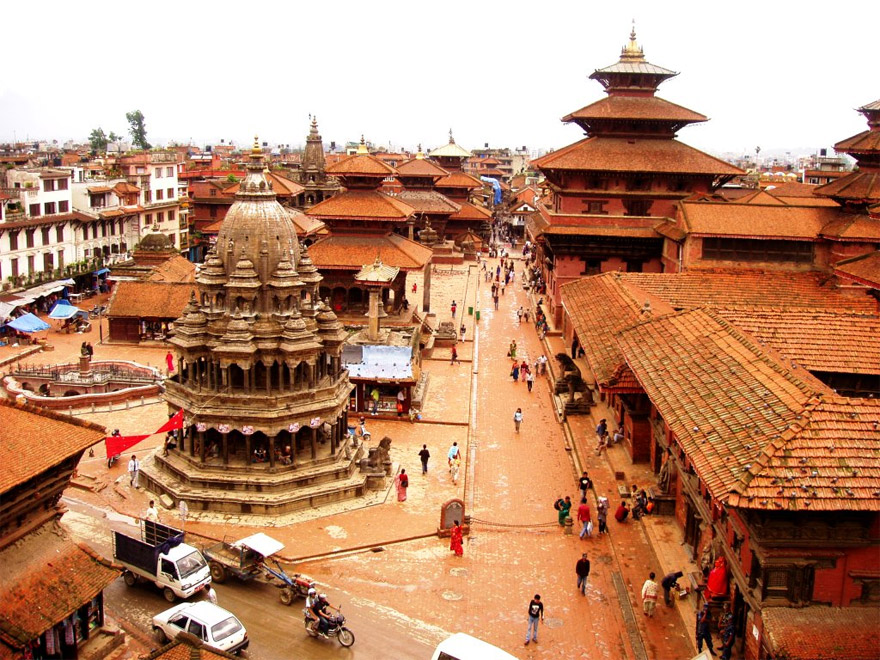
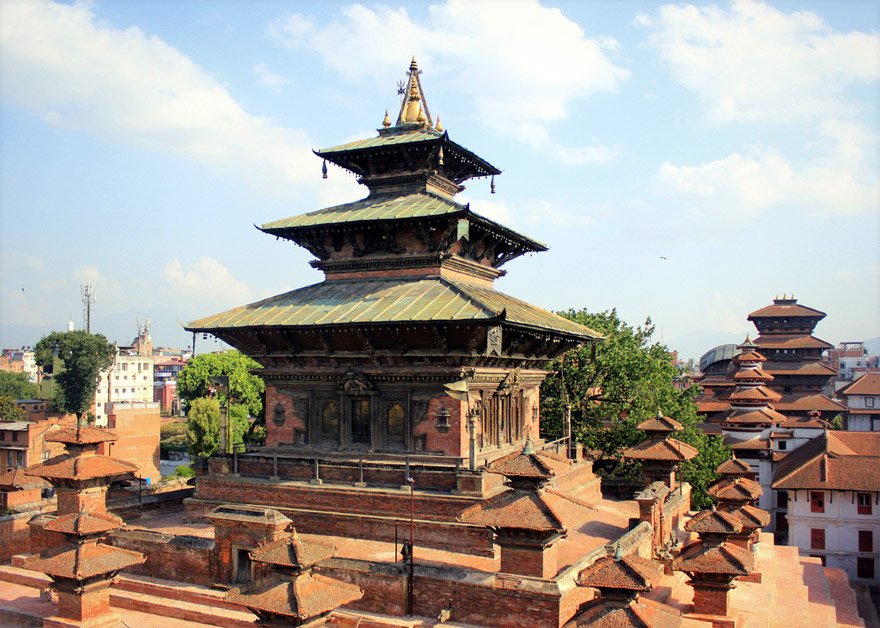
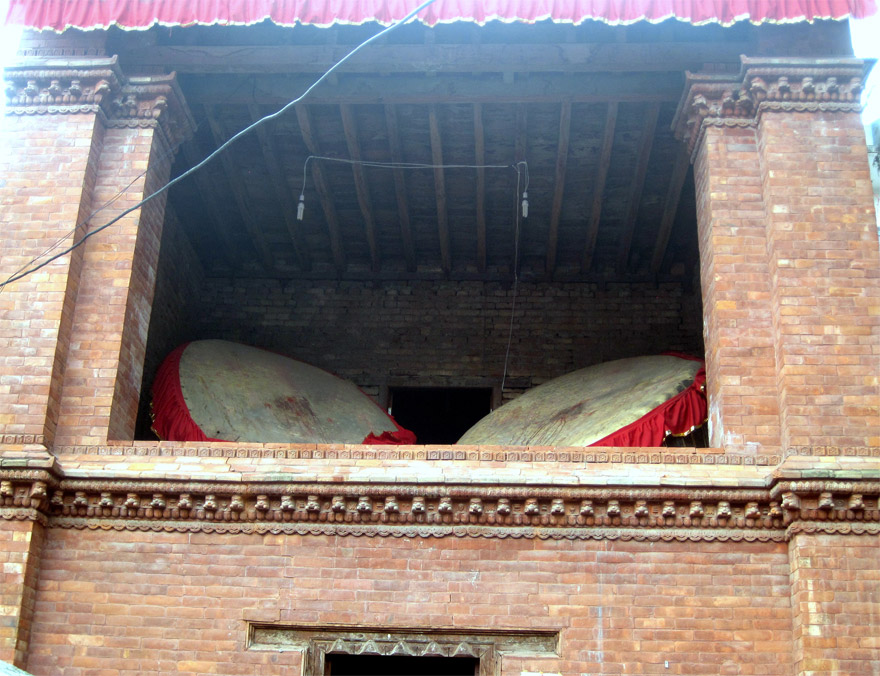
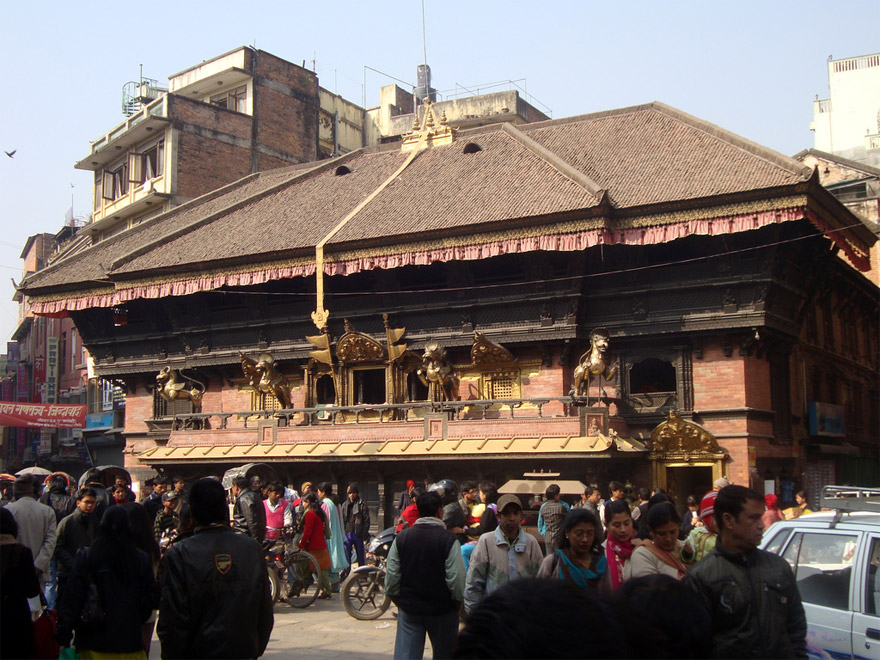
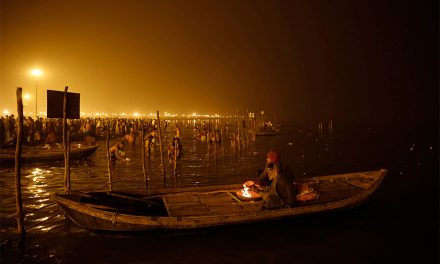










Why no mention of Pashupatinath temple and Guheshwari temple? They are the famous temples I visited when I was there. Guheshwari Tempe is one of the 51 Shaktipeeth sites as well.
Great article! The blue deity sure looks like Lord Nrsingadeva, the lion incarnation of Krishna, and the demon Hiranakashipu being killed by Him in His lap. I may have missed where you identified him. Hare Krishna!